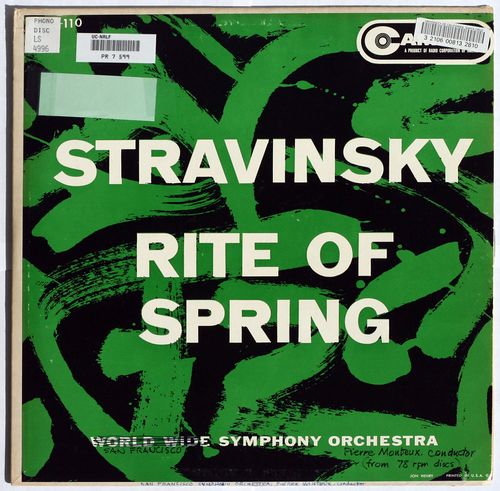The Rite Of Spring
Le Sacre du printemps (in English The Rite Of Spring) is a 1913 ballet by Igor Stravinsky about a ritual sacrifice in prehistoric times to hail the new spring. The plot was inspired by Russian pagan rituals and also quotes ancient Russian folk music. During its premier in 1913 the dissonant music shocked audiences to such a degree that a riot broke out. It made Stravinsky instantly world famous. Today The Rite Of Spring is widely seen as one of the most groundbreaking and innovative musical pieces ever composed and a true trendsetter in 20th century music.
Zappa and The Rite Of Spring
After Zappa had bought Complete Works Of Edgard Varèse, Volume 1 by Edgard Varèse he purchased a copy of The Rite Of Spring. In The Real Frank Zappa Book he describes its green-and-black abstract cover, with a magenta paper label with black lettering. In Don Paulsen interviews FZ he described it as a performance by the Worldwide Symphony Orchestra, released on the label Camden (Camden was a low-budget label for RCA Victor Records, while the World Wide Symphony Orchestra was pseudonym for the San Francisco Symphony Orchestra, conducted by Pierre Monteux) [1]: "It turned out to be a pretty good version of that, cause I've had about five records of that. So I had those two albums. I couldn't afford any more for like about two years and I wore 'em out. That and my R&B records, y'know I got about a thousand R&B records now and uhhh, I don't have The Rite Of Spring but I've still got the first riff."
In 1989, during a broadcast of Castaway's Choice, Zappa named The Rite Of Spring one of ten records he'd take to an deserted island with him.
References and musical quotes to The Rite Of Spring in Zappa's work
Music excerpts from this ballet were covered in:
- Amnesia Vivace
- Invocation And Ritual Dance Of The Young Pumpkin
- In-A-Gadda-Stravinsky
- The Return Of The Son Of Monster Magnet
- Fountain Of Love
Zappa about The Rite Of Spring
"I would probably tend to agree with Lukas Foss's evaluation of The Rite Of Spring although it's one of my favorite pieces, he feels that it's sort of like Bigger and Better Rimsky-Korsakov. In a way it is. It's more than that, but I think that the L'Histoire Du Soldat has probably got a lot more going for it in terms of real innovation and its rhythmic vitality; interesting sonorities that just didn't exist in chamber music prior to that time." - Frank Zappa in Martin Perlich interviews FZ, 1972.
Den Simms: Let me ask you somethin' else, kind of in the same vein. You obviously have quoted many times too, and you have a penchant for it, the opening notes to [Igor Stravinsky's] "The Rite Of Spring". Now, I've heard that when an orchestra plays "The Rite Of Spring", that there's this aspect of tension that settles over the orchestra, because, what is it, a bassoon that plays that note, and it's hard for him to get a good straight attack on that opening note, and everybody wonders whether he's gonna blow it or not.
Frank Zappa: "Well, I don't know whether it's correct to say the note is not on the horn, but if it is on the horn, it is one of the most difficult notes to get out of the horn."
Den Simms: Right. Is your fancy for that just because you like the line, or does it have something to do with that particular aspect of it?
Frank Zappa: "No, it's ... I like the line. I think it's a genius line."
Den Simms: Yeah, it is.
Frank Zappa: "And so is all the stuff that comes after it, which is, that's (laughs) a little hard to quote all that. (laughter)"
- Quoted from They're Doing the Interview of the Century, Part 1, April 1990.
